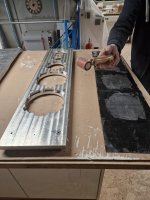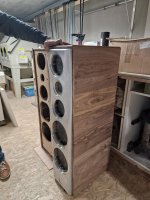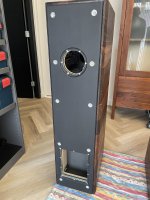Hi, that might be true. There is necessarily a cost for a project, unless main goal of the project is to make sound as cheap as possible. If main priorities for a project are in audio quality and aesthetics, there is necessarily compromises whose trade-offs are pushed into other things, like into cost and conplexity. If one is looking for top performance, it means all trade-offs need to be outside audio and in cost for example. This doesn't mean the project must be expensive, but there will be some minimum that is necessary.
You won't find a 200uF film cap for $7. Maybe $50, if you are lucky.
No, but you could find 294 small film caps for under 6€, in Europe.
Soldering work and boards not included.
I wonder if his capacitor rating correlates with price...Some capacitor opinions here, old but true? https://www.humblehomemadehifi.com/Cap.html
@tmuikku
I'm with you.
We know from studies of neurobiology that the brain has the ability to reorganize itself by forming new neural connections throughout life. This capability allows the brain to adjust its activity in response to new stimuli, situations, changes in the environment etc. This ability to rewire itself plays a crucial role in playing a musical instrument or learning a new language; the brain creates and strengthens pathways to support that skill. The brain can learn new things, even after injury.
We call this neuroplasticity.
It's probably no surprise to many of us that the brain is highly adaptable. The corollary of this is that with repetition, it becomes easier for the brain. The next time we experience an event, the experience is not the quite the same as the first time. The first time you experience the Eiffel tower or Big Ben with your love is an experience that cannot be repeated- as you do it over and over, as it becomes familiar, the brain doesn't need to make new connections.
This is self evident- your favorite recorded album, as you listen to it over and over and over...
The brain likes novelty.
And this guarantee's humankind's perpetual search.
It's like that mirage in the desert- you will keep going, but perfection is but an illusion.
I'm with you.
We know from studies of neurobiology that the brain has the ability to reorganize itself by forming new neural connections throughout life. This capability allows the brain to adjust its activity in response to new stimuli, situations, changes in the environment etc. This ability to rewire itself plays a crucial role in playing a musical instrument or learning a new language; the brain creates and strengthens pathways to support that skill. The brain can learn new things, even after injury.
We call this neuroplasticity.
It's probably no surprise to many of us that the brain is highly adaptable. The corollary of this is that with repetition, it becomes easier for the brain. The next time we experience an event, the experience is not the quite the same as the first time. The first time you experience the Eiffel tower or Big Ben with your love is an experience that cannot be repeated- as you do it over and over, as it becomes familiar, the brain doesn't need to make new connections.
This is self evident- your favorite recorded album, as you listen to it over and over and over...
The brain likes novelty.
And this guarantee's humankind's perpetual search.
It's like that mirage in the desert- you will keep going, but perfection is but an illusion.
Last edited:
That's why its good to rotate amplifiers, or preamps, or even speakers from time to time.
^^ I've been really into this philosophical concept that the conscious brain that is me, my thoughts, my perceptions, is on top of rest of the brain which I do not have conscious control of. All sensory inputs go to the parts of brain I have no control of, which then processes the data in various ways I have no control over, and provide a perception into my consciousness, the sound I perceive. We are basically listening our auditory system, not sound that enters the ear canal, but what the auditory system makes out of it. For example, there is processing in auditory system that filters out heart pulse and sound of blood rushing in veins in order to make sense what the world around me sounds like. Ear really can send astronomical amount of nerve firings, which gets filtered and so on, turned into audio for consciousness based on what the brain somehow decides is important to be in our consciousness, and filters out the rest.
This really opens up perspective on things. Knowing this enables experimentation how to indirectly affect the auditory system, the processing, in order to consciously change how the perception appears. Simplest thing is to play with attention: If I move myself back and forth at ~listening spot I can make my brain pay attention to the sound or not, the Griesinger stuff 😀 Massive change perceptually, even if the speakers and room are exactly the same, my brain processing just changes.
But, being aware of this it also allows me to come up with all kinds of AB tests, really heighten listening skill as I'm aware that I'm listening my own brain, not my ear canal. For example, use your mobile phone, play pink noise and point it towards boundaries and the auditory system really picks it up, gets sensitive to the reflections after few minutes. Now put your mobile aside and put noise on your stereo system and keep on experimenting one speaker only, suddenly you are quite aware of loud early reflections behind and sides of you for example.
Another example is just to acknowledge how much the brain affects perception so that not all differences in perception are from equipment directly. This helps to be aware and really pay attention in what state the auditory system likely is at any occasion when trying to compare something to something else. For example, if one compares speakers, the other having different coverage than the other making your brain pay attention to it better than to the other with the same listening triangle. This is huge difference perceptually, although the another pair could have made you pay attention as well if you just shrunk the listening triangle a bit to allow it to. This stuff is missing from ~all gear reviews for example, there is no context to relate auditory system to, which makes the tests somewhat just noise, not possible to relate to especially when a reader doesn't even know it needs to relate somehow. Perception can vary wildly just due to (state of brain), even if the gear was exactly the same.
Well, this stuff might not seem true, and I'm writing about it colorfully, but believe me if you start paying attention to this stuff like so your listening skill will ramp up and this stuff becomes quite audible = reduced confusion in general. Just experiment away, try to connect logic what you perceive to be able to reason with it.
This really opens up perspective on things. Knowing this enables experimentation how to indirectly affect the auditory system, the processing, in order to consciously change how the perception appears. Simplest thing is to play with attention: If I move myself back and forth at ~listening spot I can make my brain pay attention to the sound or not, the Griesinger stuff 😀 Massive change perceptually, even if the speakers and room are exactly the same, my brain processing just changes.
But, being aware of this it also allows me to come up with all kinds of AB tests, really heighten listening skill as I'm aware that I'm listening my own brain, not my ear canal. For example, use your mobile phone, play pink noise and point it towards boundaries and the auditory system really picks it up, gets sensitive to the reflections after few minutes. Now put your mobile aside and put noise on your stereo system and keep on experimenting one speaker only, suddenly you are quite aware of loud early reflections behind and sides of you for example.
Another example is just to acknowledge how much the brain affects perception so that not all differences in perception are from equipment directly. This helps to be aware and really pay attention in what state the auditory system likely is at any occasion when trying to compare something to something else. For example, if one compares speakers, the other having different coverage than the other making your brain pay attention to it better than to the other with the same listening triangle. This is huge difference perceptually, although the another pair could have made you pay attention as well if you just shrunk the listening triangle a bit to allow it to. This stuff is missing from ~all gear reviews for example, there is no context to relate auditory system to, which makes the tests somewhat just noise, not possible to relate to especially when a reader doesn't even know it needs to relate somehow. Perception can vary wildly just due to (state of brain), even if the gear was exactly the same.
Well, this stuff might not seem true, and I'm writing about it colorfully, but believe me if you start paying attention to this stuff like so your listening skill will ramp up and this stuff becomes quite audible = reduced confusion in general. Just experiment away, try to connect logic what you perceive to be able to reason with it.
Last edited:
Did you hear the one where one of the reviewers for Soundstagehifi.com, (perhaps accidentally) disclosed that Doug Schneider, the found of this website, urged him to
'Write the review when you're excited!'
'Write the review when you're excited!'
Last edited:
I am away for 10 days and I don’t recognize my thread anymore.
Well with unfortunate little time (I still need to work an help my son in his 1953 build house) we glued EPDM to the back of the aluminum panels and cut-out the holes. Not a very interesting job, but it needed to be done.
Next some work on the wood panels and put leather over the aluminum.
Well with unfortunate little time (I still need to work an help my son in his 1953 build house) we glued EPDM to the back of the aluminum panels and cut-out the holes. Not a very interesting job, but it needed to be done.
Next some work on the wood panels and put leather over the aluminum.
Attachments
Time for an update, a lot of small things were done the last 2 weeks.
Adding a chamfer to the sides

wetting between sanding so the hairs pop out

After a few hour sanding very smooth surface ready for oil

next to the "old" 2017 build surround speaker with upfiring Atmos section. My wife is quite happy with new size. The previous were quite big


home made start-quad OFC cables for internal wiring dual 1,6mm2 for mid dual 0,5mm2 for high.

adding two layers of bituminous over the MID port

The tension rods welded and added 3 layers of heat-shrink tubing.


Adding letherette to the rear panel, and fitting the mid port flange.
So the last tasks are putting the speakers in a protective enhanced Tung-Oil and adding leatherette to the aluminium front panels.
And then start mounting it all together so the tuning can start
Take care
Peter
Adding a chamfer to the sides
wetting between sanding so the hairs pop out
After a few hour sanding very smooth surface ready for oil
next to the "old" 2017 build surround speaker with upfiring Atmos section. My wife is quite happy with new size. The previous were quite big
home made start-quad OFC cables for internal wiring dual 1,6mm2 for mid dual 0,5mm2 for high.
adding two layers of bituminous over the MID port
The tension rods welded and added 3 layers of heat-shrink tubing.
Adding letherette to the rear panel, and fitting the mid port flange.
So the last tasks are putting the speakers in a protective enhanced Tung-Oil and adding leatherette to the aluminium front panels.
And then start mounting it all together so the tuning can start
Take care
Peter
and a few update pictures.

the first front wrapped in letherette

clean corners

A polished backside as my fried likes to keep them blank aluminium

Drilling straight holes for threaded inserts

mounting holes for RAMPAs threaded insert

checking the base plate

the first coat of natural Tung Oil
......................... we are getting close
the first front wrapped in letherette
clean corners
A polished backside as my fried likes to keep them blank aluminium
Drilling straight holes for threaded inserts
mounting holes for RAMPAs threaded insert
checking the base plate
the first coat of natural Tung Oil
......................... we are getting close
So after a thorough sanding up to 320 grid, another oil layer and another layer after using a scouring pad I think the enclosure is okay.

before left and after rubbing the excessive oil off ....

the second layer of oil



and the final layer of oil.
next is finishing the letherette cover of front and back, and mounting them with the ten M8 rods to the enclosure.
Cheers, Peter
before left and after rubbing the excessive oil off ....
the second layer of oil
and the final layer of oil.
next is finishing the letherette cover of front and back, and mounting them with the ten M8 rods to the enclosure.
Cheers, Peter
Hi Forum, some nice progress has been made this weekend.
The front and rear panels are covered in letherette and some assembling can be done.
We decided to go for an extra layer of open cell EPDM between front/rear and enclosure.

3mm layer of EPDM that can be compressed upto 1mm


Cutout the holes

adding the metal rods to the front baffle

Wiggling the 10 rods trough all holes and compartments

Mounting the rear with M9 bolts



Close up of front, and all the layers

The inside of the midrange with added felt
The mid and HF cables are in, and I used some boat-kit to fill the holes where the rods pass the midrange part of the enclosure.
The weight is now around 80 kg. when de base and speakers are mounted I expect 100/105 kg.
Cheers,
Peter
The front and rear panels are covered in letherette and some assembling can be done.
We decided to go for an extra layer of open cell EPDM between front/rear and enclosure.
3mm layer of EPDM that can be compressed upto 1mm
Cutout the holes
adding the metal rods to the front baffle
Wiggling the 10 rods trough all holes and compartments
Mounting the rear with M9 bolts
Close up of front, and all the layers
The inside of the midrange with added felt
The mid and HF cables are in, and I used some boat-kit to fill the holes where the rods pass the midrange part of the enclosure.
The weight is now around 80 kg. when de base and speakers are mounted I expect 100/105 kg.
Cheers,
Peter
Attachments
Dear forum, the speakers are finished, the tuning can start....
Latest building pics:

mounting the base

Adding a bitumen dampening to the underside of the port just touching the lowest brace so it can be removed for adjusting the length tuning

adding damping material


soldering speaker wires and fastening them with cable-binders

The midrange flange-port
Latest building pics:
mounting the base
Adding a bitumen dampening to the underside of the port just touching the lowest brace so it can be removed for adjusting the length tuning
adding damping material
soldering speaker wires and fastening them with cable-binders
The midrange flange-port
Last edited:
And some beauty shots






I did not have enough of the right (best looking screws for the midrange (the shallow ones in the wooferes) but they will be replaced later
TUNING.............. 🙂
Stay tuned .... haha
Peter
I did not have enough of the right (best looking screws for the midrange (the shallow ones in the wooferes) but they will be replaced later
TUNING.............. 🙂
Stay tuned .... haha
Peter
- Home
- Loudspeakers
- Multi-Way
- Building the best 3-way (NOT) full range speaker in the world



